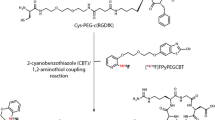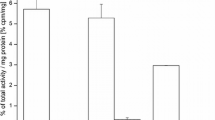Abstract
Purpose
A molecular target involved in the angiogenic process is the αvβ3 integrin. It has been demonstrated in preclinical as well as in clinical studies that radiolabelled RGD peptides and positron emission tomography (PET) allow noninvasive monitoring of αvβ3 expression. Here we introduce a 68Ga-labelled NOTA-conjugated RGD peptide ([68Ga]NODAGA-RGD) and compare its imaging properties with [68Ga]DOTA-RGD using small animal PET.
Methods
Synthesis of c(RGDfK(NODAGA)) was based on solid phase peptide synthesis protocols using the Fmoc strategy. The 68Ga labelling protocol was optimized concerning temperature, peptide concentration and reaction time. For in vitro characterization, partition coefficient, protein binding properties, serum stability, αvβ3 binding affinity and cell uptake were determined. To characterize the in vivo properties, biodistribution studies and microPET imaging were carried out. For both in vitro and in vivo evaluation, αvβ3-positive human melanoma M21 and αvβ3-negative M21-L cells were used.
Results
[68Ga]NODAGA-RGD can be produced within 5 min at room temperature with high radiochemical yield and purity (> 96%). In vitro evaluation showed high αvβ3 binding affinity (IC50 = 4.7 ± 1.6 nM) and receptor-specific uptake. The radiotracer was stable in phosphate-buffered saline, pH 7.4, FeCl3 solution, and human serum. Protein-bound activity after 180 min incubation was found to be 12-fold lower than for [68Ga]DOTA-RGD. Biodistribution data 60 min post-injection confirmed receptor-specific tumour accumulation. The activity concentration of [68Ga]NODAGA-RGD was lower than [68Ga]DOTA-RGD in all organs and tissues investigated, leading to an improved tumour to blood ratio ([68Ga]NODAGA-RGD: 11, [68Ga]DOTA-RGD: 4). MicroPET imaging confirmed the improved imaging properties of [68Ga]NODAGA-RGD compared to [68Ga]DOTA-RGD.
Conclusion
The introduced [68Ga]NODAGA-RGD combines easy accessibility with high stability and good imaging properties making it an interesting alternative to the 18F-labelled RGD peptides currently used for imaging αvβ3 expression.







Similar content being viewed by others
References
Szekanecz Z, Besenyei T, Szentpétery A, Koch AE. Angiogenesis and vasculogenesis in rheumatoid arthritis. Curr Opin Rheumatol 2010;22:299–306.
Heidenreich R, Röcken M, Ghoreschi K. Angiogenesis drives psoriasis pathogenesis. Int J Exp Pathol 2009;90:232–48.
Langer HF, Haubner R, Pichler BJ, Gawaz M. Radionuclide imaging: a molecular key to the atherosclerotic plaque. J Am Coll Cardiol 2008;52:1–12.
Folkman J. Angiogenesis: an organizing principle for drug discovery? Nat Rev Drug Discov 2007;6:273–86.
Sheldrake HM, Patterson LH. Function and antagonism of beta3 integrins in the development of cancer therapy. Curr Cancer Drug Targets 2009;9:519–40.
Haubner R, Decristoforo C. Radiolabelled RGD peptides and peptidomimetics for tumour targeting. Front Biosci 2009;14:872–86.
Ruoslahti E, Pierschbacher MD. New perspectives in cell adhesion: RGD and integrins. Science 1987;238:491–7.
Haubner R, Wester HJ, Reuning U, Senekowitsch-Schmidtke R, Diefenbach B, Kessler H, et al. Radiolabeled alpha(v)beta3 antagonists: a new class of tracers for tumor targeting. J Nucl Med 1999;40:1061–71.
Haubner R, Beer A, Wang H, Chen X. Positron emission tomography tracers for imaging angiogenesis. Eur J Nucl Med Mol Imaging 2010;37 Suppl 1:S86–103.
Haubner R, Kuhnast B, Mang C, Weber WA, Kessler H, Wester HJ, et al. [18F]Galacto-RGD: synthesis, radiolabeling, metabolic stability, and radiation dose estimates. Bioconjug Chem 2004;15:61–9.
Decristoforo C, Hernandez Gonzalez I, Carlsen J, Rupprich M, Huisman M, Virgolini I, et al. (68)Ga- and (111)In-labelled DOTA-RGD peptides for imaging of alphavbeta3 integrin expression. Eur J Nucl Med Mol Imaging 2008;35:1507–15.
Sun Y, Anderson CJ, Pajeau TS, Reichert DE, Hancock RD, Motekaitis RJ, et al. Indium(III) and gallium(III) complexes of bis(aminoethanethiol) ligands with different denticities: stabilities, molecular modeling, and in vivo behavior. J Med Chem 1996;39:458–70.
Eisenwiener KP, Prata MI, Buschmann I, Zhang HW, Santos AC, Wenger S, et al. NODAGATOC, a new chelator-coupled somatostatin analogue labeled with [67/68Ga] and [111In] for SPECT, PET, and targeted therapeutic applications of somatostatin receptor (hsst2) expressing tumors. Bioconjug Chem 2002;13:530–41.
Haubner R, Wester HJ, Burkhart F, Senekowitsch-Schmidtke R, Weber W, Goodman SL, et al. Glycosylated RGD-containing peptides: tracer for tumor targeting and angiogenesis imaging with improved biokinetics. J Nucl Med 2001;42:326–36.
Decristoforo C, Santos I, Pietzsch HJ, Kuenstler JU, Duatti A, Smith CJ, et al. Comparison of in vitro and in vivo properties of [99mTc]cRGD peptides labeled using different novel Tc-cores. Q J Nucl Med Mol Imaging 2007;51:33–41.
Kurtaran A, Müller C, Novacek G, Kaserer K, Mentes M, Raderer M, et al. Distinction between hepatic focal nodular hyperplasia and malignant liver lesions using technetium-99m-galactosyl-neoglycoalbumin. J Nucl Med 1997;38:1912–5.
Shannon RD. Revised effective ionic radii and systematic studies of interatomic distances in halides and chalcogenides. Acta Crystallogr A 1976;32:751–67.
Reichert D, Lewis J, Anderson C. Metal complexes as diagnostic tools. Coord Chem Rev 1999;184:3–66.
Haubner R, Wester HJ, Weber WA, Mang C, Ziegler SI, Goodman SL, et al. Noninvasive imaging of αvβ3 integrin expression using 18F-labeled RGD-containing glycopeptide and positron emission tomography. Cancer Res 2001;61:1781–5.
Jeong JM, Hong MK, Chang YS, Lee YS, Kim YJ, Cheon GJ, et al. Preparation of a promising angiogenesis PET imaging agent: 68Ga-labeled c(RGDyK)-isothiocyanatobenzyl-1,4,7-triazacyclononane-1,4,7-triacetic acid and feasibility studies in mice. J Nucl Med 2008;49:830–6.
Li ZB, Chen K, Chen X. (68)Ga-labeled multimeric RGD peptides for microPET imaging of integrin alpha(v)beta (3) expression. Eur J Nucl Med Mol Imaging 2008;35:1100–8.
Liu S, Liu Z, Chen K, Yan Y, Watzlowik P, Wester HJ, et al. (18)F-Labeled Galacto and PEGylated RGD dimers for PET imaging of αvβ3 integrin expression. Mol Imaging Biol 2010;12:530–8.
Acknowledgement
Bettina Sarg and Sabine Hofer, Protein Micro Analysis Facility, Biocenter, Innsbruck Medical University are acknowledged for carrying out the LC-MS analysis. We thank Alexander Staaf, Department of Pharmaceutical Chemistry, University of Innsbruck for providing analytical data concerning synthesis of the chelator. David A. Cheresh, The Scripps Research Institute, La Jolla, CA is acknowledged for providing the human melanoma M21 and M21-L cells. Parts of the studies were financially supported by the BMBF-MoBiMed grant. This work was part of COST Action BM0607 “Targeted Radionuclide Therapy”.
Conflicts of interest
None.
Author information
Authors and Affiliations
Corresponding author
Rights and permissions
About this article
Cite this article
Knetsch, P.A., Petrik, M., Griessinger, C.M. et al. [68Ga]NODAGA-RGD for imaging αvβ3 integrin expression. Eur J Nucl Med Mol Imaging 38, 1303–1312 (2011). https://doi.org/10.1007/s00259-011-1778-0
Received:
Accepted:
Published:
Issue Date:
DOI: https://doi.org/10.1007/s00259-011-1778-0




